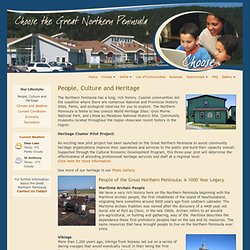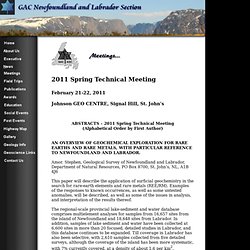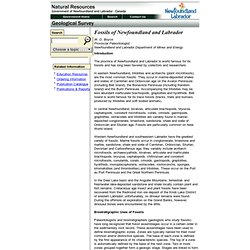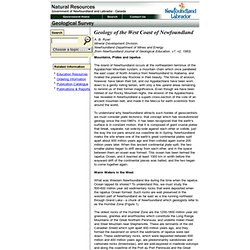

GAC Newfoundland Section - FIELD TRIP GUIDEBOOKS. The Glynmill Inn to Trout River, NL. Corner Brook Plaza to Bellburns, NL, Canada. Corner Brook Plaza to Bellburns, NL, Canada. People, Culture and Heritage : Great Northern Peninsula. The Northern Peninsula has a long, rich history.

Coastal communities dot the coastline where there are numerous National and Provincial Historic Sites, Parks, and ecological reserves for you to explore. The Northern Peninsula is home to two Unesco World Heritage Sites: Gros Morne National Park, and L'Anse au Meadows National Historic Site. Community museums located throughout the region showcase recent history in the region. Heritage Cluster Pilot Project: An exciting new pilot project has been launched on the Great Northern Peninsula to assist community heritage organizations improve their operations and services to the public and build their capacity overall.
See more of our heritage in our Photo Gallery. People of the Great Northern Peninsula: A 1000 Year Legacy Vikings More than 1,200 years ago, Vikings from Norway set out on a series of daring voyages that would eventually result in their being the first Europeans to explore the east coast of North America. Johnson GEO CENTRE. GAC Newfoundland Section - FIELD TRIP GUIDEBOOKS. GAC Newfoundland Section - Geoscience Links. ABSTRACTS. ABSTRACTS - 2011 Spring Technical Meeting (Alphabetical Order by First Author) Amor.

Stephen, Geological Survey of Newfoundland and Labrador, Department of Natural Resources, PO Box 8700, St. John’s, NL, A1B 4J6 This paper will describe the application of surficial geochemistry in the search for rare-earth elements and rare metals (REE/RM). Examples of the responses to known occurrences, as well as some untested anomalies, will be described, as well as some of the issues in analysis, and interpretation of the results thereof. The regional-scale provincial lake-sediment and water database comprises multielement analyses for samples from 16,657 sites from the island of Newfoundland and 18,648 sites from Labrador. There are numerous REE/RM anomalies in both Newfoundland and Labrador.
Education & Outreach. Compiled by David Liverman, Martin Batterson and David Taylor A geological disaster occurs when natural geological processes impact on our activities, either through loss of life, injury, or economic loss.

The Geological Survey has compiled a historical record of geological disasters from a wide range of sources over several years of research. In the course of archival research any natural hazard that might fall in the area of geological phenomena was noted. Purely weather-related phenomena mostly are excluded, but major storms that cause considerable damage and loss of life, especially amongst the fishing community probably are the most significant natural hazard in the Province. Many of the disasters noted are intimately associated with severe weather.
This record demonstrates that the province was affected by numerous geological disasters that inflicted a major economic and social cost. Recent additions. Geological Survey. Geological Survey. Introduction The province of Newfoundland and Labrador is world famous for its fossils and has long been favored by collectors and researchers.

In eastern Newfoundland, trilobites and acritarchs (plant microfossils) are the most common fossils. They occur in marine-deposited shales and slates of Cambrian and Ordovician age on the Avalon Peninsula (including Bell Island), the Bonavista Peninsula (including Random Island) and the Burin Peninsula. Accompanying the trilobites may be less abundant inarticulate brachiopods, graptolites and hyolithids. Bell Island is world famous for its trace fossils (tracks, trails and burrows produced by trilobites and soft bodied animals). Cover_menu.jpg (JPEG Image, 2511 × 2541 pixels)
Geological Survey. Mountains, Plates and Iapetus The island of Newfoundland occurs at the northeastern terminus of the Appalachian Mountain system, a mountain chain which once paralleled the east coast of North America from Newfoundland to Alabama, and rivalled the present-day Rockies in their beauty.

The forces of erosion, however, have taken their toll, and our Appalachians have been worn down to a gently rolling terrain, with only a few upland areas remaining to remind us of their former magnificence. Even though we have been robbed of our Rocky Mountain highs, the erosion of the Appalachians has revealed in Newfoundland a superb cross-section of the core of an ancient mountain belt, and made it the Mecca for earth scientists from around the world. To understand why Newfoundland attracts such hordes of geoscientists we must consider plate tectonics, that concept which has revolutionized geology since the mid-1960's.
Warm Waters in the West Ophiolites and West Coast Splendour Deer Lake and Death Valley.